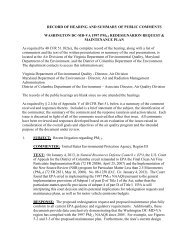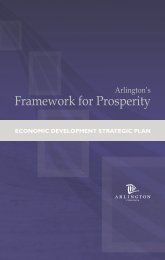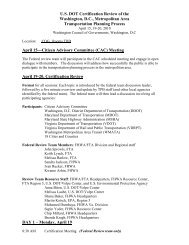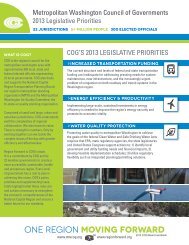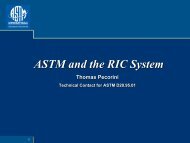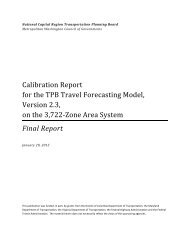PTI Local Government Energy Assurance Guidelines - Metropolitan ...
PTI Local Government Energy Assurance Guidelines - Metropolitan ...
PTI Local Government Energy Assurance Guidelines - Metropolitan ...
Create successful ePaper yourself
Turn your PDF publications into a flip-book with our unique Google optimized e-Paper software.
Emergency<br />
Management Agency<br />
Emergency Operations<br />
Center (EOC)<br />
Emergency Support<br />
Functions (ESFs)<br />
<strong>Energy</strong> <strong>Assurance</strong><br />
<strong>Energy</strong> <strong>Assurance</strong><br />
Coordinator<br />
<strong>Energy</strong> <strong>Assurance</strong><br />
Partners<br />
<strong>Energy</strong> Efficiency<br />
<strong>Energy</strong> Infrastructure<br />
<strong>Energy</strong> Supplier<br />
Essential Services and<br />
Functions<br />
Federal Emergency<br />
Management Agency<br />
(FEMA)<br />
Geomagnetic<br />
Disturbance<br />
Independent Power<br />
Producer (IPP)<br />
Investor-Owned Utility<br />
(IOU)<br />
An agency at the local, regional, or State level that holds responsibility for<br />
comprehensively planning for and responding to all manner of disasters, whether manmade<br />
or natural.<br />
A central command and control facility responsible for carrying out the principles of<br />
emergency preparedness and emergency management, or disaster management<br />
functions at a strategic level in an emergency situation, and ensuring the continuity of<br />
operations of a company, political subdivision, or other organization.<br />
Grouping of governmental and certain private sector capabilities into an organizational<br />
structure to provide support, resources, program implementation, and services that are<br />
most likely needed to save lives, protect property and the environment, restore essential<br />
services and critical infrastructure, and help victims and communities return to normal<br />
following domestic incidents.<br />
Involves a vast array of activities, and falls into three main categories: preparation and<br />
planning, mitigation and response, and education and outreach. Preparation and planning<br />
involve identifying key assets and points-of-contact, designing and updating energy<br />
emergency response plans, training personnel, and conducting exercises that test the<br />
effectiveness of response plans. Mitigation and response activities include monitoring<br />
events that may affect energy supplies, assessing the severity of disruptions, providing<br />
situational awareness, coordinating restoration efforts, and tracking recoveries. Education<br />
and outreach activities include communicating and coordinating with key stakeholders,<br />
increasing public awareness, and forming partnerships across sectors and jurisdictions.<br />
The individual responsible for leading and building consensus around EAP development<br />
and implementation.<br />
The group of stakeholders that work with the energy assurance coordinator to develop<br />
and implement the EAP for a local government.<br />
Using less energy to provide the same level of energy service or to perform the same level<br />
of work.<br />
Pipelines, power plants, distribution networks, transmission lines, and the like.<br />
An entity—utility or otherwise—that supplies energy in its various forms (electricity, natural<br />
gas, petroleum fuel, etc.) to a local jurisdiction.<br />
Services a local government must provide and functions performed in order to assure<br />
safety, wellbeing, and security for its inhabitants. Most often these services are mandated<br />
in a jurisdiction’s charter or enabling legislation and paid for by property and/or sales<br />
taxes, fees, and the like.<br />
The Federal Emergency Management Agency coordinates the Federal government’s role<br />
in preparing for, preventing, mitigating the effects of, responding to, and recovering from<br />
all domestic disasters, whether natural or man-made, including acts of terror.<br />
A temporary disturbance of the Earth’s magnetosphere caused by a disturbance in<br />
space weather. Associated with solar flares and resultant solar coronal mass ejections<br />
(CME), a geomagnetic storm can severely impact electricity transmission and distribution<br />
equipment, among other critical infrastructure.<br />
An entity that is not a public utility, but which owns facilities to generate electric power<br />
for sale to utilities and end users. IPPs may be privately-held facilities, cooperatives such<br />
as rural solar or wind energy producers, and other industrial concerns capable of feeding<br />
excess energy into the system.<br />
A business organization providing a product or service regarded as a utility (often termed<br />
a public utility regardless of ownership), and managed as a private enterprise rather than<br />
as a function of government or a utility cooperative. An IOU is typically a regulated entity<br />
at the State level. As such, the regulatory body (e.g., Public Utility Commission) may<br />
dictate required responsibilities that differ from State to State.<br />
80 | Appendix A – Glossary of Key Terms



